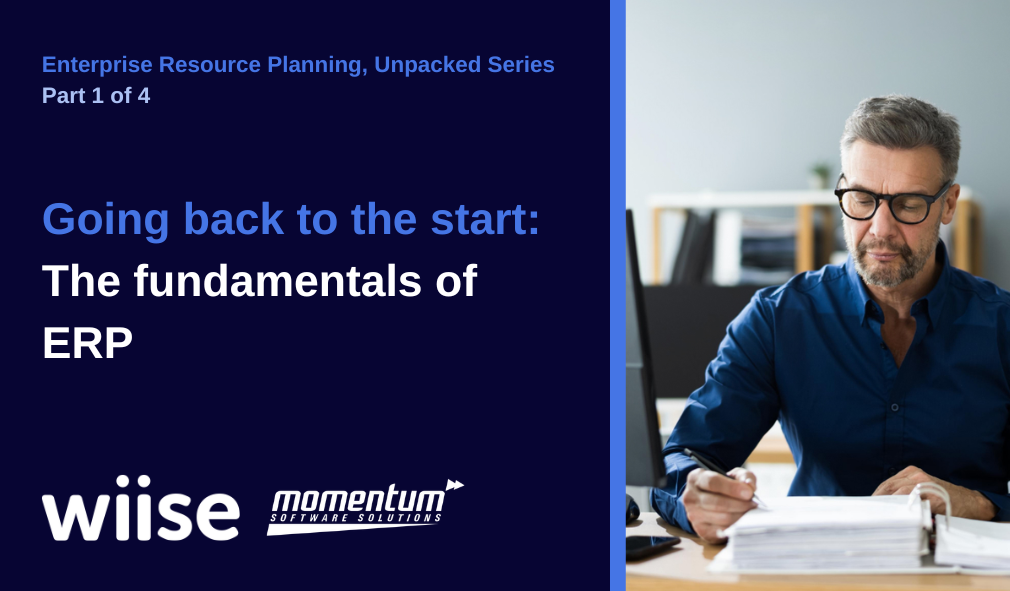The following article has been created by Wiise. View the original article here.
Enterprise Resource Planning, Unpacked
If you’ve googled ‘what is ERP’ recently, you’ve likely found dozens of explanations, but not any that are jargon-free or easy-to-understand. Wiise’s new series Enterprise Resource Planning, Unpacked aims to resolve this issue once and for all. The hope is that this series can help you think of ERP as being the key to achieving organisational goals— and not as an acronym for something really long that you struggle to remember.
The first article in the Wiise series tackles the fundamentals, such as the definition of ERP, the evolution of ERP systems, and how ERP systems work before describing how a modern ERP solution can make life easier for various teams within an organisation.
What is ERP?
ERP stands for Enterprise Resource Planning. There are lots of different definitions of ERP out there: some refer to it as ‘connecting front, middle, and back offices’, while others call it the ‘integrated management of key business processes mediated by software’ and so on. And part of the reason for these varied definitions is that Enterprise Resource Planning refers both to the process it describes as well as the software that can help manage it.
Here’s the most straightforward way to think about Enterprise Resource Planning.
You have a business—that’s your Enterprise. Your business is made up of lots of different parts—be it people, equipment, inventory, capital, or data—that’s the Resource(s). Finally, operating your business with some degree of success requires a fair bit of strategising and making the right decisions at the right times: another word for which is Planning.
A good rule of thumb is that when Enterprise Resource Planning is spelled out in full, it generally refers to the process. The acronym form is almost always followed by software, solution, or system and refers to the tools that enable an organisation’s enterprise resource planning capabilities.
A brief history of ERP systems
The roots of ERP trace back to the 1960s when manufacturers developed Materials Requirement Planning or MRP software to automatically calculate the components to order for a given sales forecast. The scope of MRP systems gradually expanded to include more business functions such as accounting, distribution, HR, Sales and more.
In 1990, analytics firm Gartner coined the term Enterprise Resource Planning to describe a new class of software that brought together business functions such as accounting, sales, operations, and HR to serve as a single source of truth of data for the entire organisation.

Why do you need an ERP system?
The foremost concern for small and mid-sized businesses that have just started out is staying on top of cash flow. So, accounting software such as Xero or QuickBooks becomes their go-to. Respective teams might manually calculate landed costs or create quotes using spreadsheets, but before long, the need to invest in more solutions becomes inevitable—be it for inventory management, payroll, ecommerce, or reporting.
The result is almost always a patchwork of solutions that don’t always talk to each other.
Instead of asking yourself whether your business needs an ERP solution, start by asking these questions about your current system:
- Does it allow your teams to get work done quickly?
- Given the multiple costs, both ongoing and one-off, is it still cost-efficient?
- Is it easy to add new productivity tools to the mix?
- Is it scalable? That is, will it need to be ripped up and thrown out if your business experienced a boom?
Recognising where your current system is failing to support your short and long-term business objectives is the first step in your business transformation journey with a modern ERP.
The benefits of an ERP system for your business
The benefits of a modern ERP system can range from speeding up day-to-day tasks to streamlining the entire quote-to-cash process to harnessing technologies such as Artificial Intelligence (AI) and Robotic Process Automation to dramatically transform how your business operates.
The outcomes depend on how the ERP solution is configured, which modules are deployed, and what features are built into the ERP solution to start with but at the very minimum, the benefits offered by an ERP system include:
- Business-wide visibility
- Informed decision-making
- Seamlessly connected functions
- Efficiency and higher productivity
- Resilience to risk and disruption
- Peace of mind with compliance and security
- Agility and greater control over business

How does an ERP system work?
There are three things that ERP software does to unlock an endless list of possibilities for business.
Integration: Integrated systems, better-connected teams
An ERP system integrates key business functions to allow for information exchange between them—in real-time. Let’s break that down.
Think about those parts of your business that use different software, causing bits of business data to end up stranded in various systems such as your CRM or accounting system—or worse, in a spreadsheet saved on the desktop of an employee who’s about to go away on long-service leave. Gauging business performance based on multiple, fragmented sources of information is both frustrating and risky.
Using multiple systems with little to no integration is like working in an office with lots of walled rooms and the departments are all located on different levels of the building. Anytime you want to ask someone a quick question, their door is shut or they’re not at their desk. It could be hours before you get your hands on the information you need. Maybe knocking down every last wall, locked door, and closed room to create a sprawling open-plan office would make life easier.
In essence, that’s what an ERP system does: it removes the barriers between various departments to give you a clear view of your entire business—at a glance.
Automation: Automated information exchange
By integrating key business functions, an ERP system makes real-time information exchange between them possible but it also automates this process. For instance, with an ERP system, data entered just once at the point of sale can do three things at the same time and automatically:
- generate a shipping label for distribution
- create an invoice for accounting
- update inventory levels
Other scenarios where this comes in handy include purchasing teams getting notified when inventory levels dip below a set point or new pricing that only needs to be updated in the system once before it’s reflected everywhere, or your customer service team being able to look up stock availability while on the phone to customers without having to contact the warehouse team.
Secondly, ERP solutions use logic to reduce the manual input required in day-to-day tasks. Not only does this speed up critical business processes, it also frees up your team to focus on higher-value tasks.
For instance, your finance team could be taking weeks to prepare reports but an ERP system has the ability to generate up-to-date, consolidated views of financial data from across the business—on demand—allowing the same finance team to spend their time analysing data rather than hunting around for it.
Intelligence: Real-time insights and business intelligence
Modern ERP systems have technologies such as AI, machine learning and advanced analytics built into them to offer organisations of any size the business intelligence necessary to gain a competitive edge and thrive in a competitive world.
An ERP system uses the data that your business already generates to analyse, learn and make predictions about your business, letting you make the most of opportunities, but also identify risks and put contingency plans in place.
For a growing business, intelligence takes the form of real-time insights that can help the organisation understand not just what’s happening across functions but also know why it’s happening as it’s happening—in real time.
Investing in an ERP solution is key to business owners feeling in control at all times and enables them to anticipate change and make well-informed decisions with speed and confidence.
Who can benefit from an ERP solution?
By connecting various business functions, an ERP system impacts every team and team member. Here’s how:
- Finance teams can close the books faster
- Sales teams can process orders effortlessly
- Operations teams can deliver orders in full and on time
- Customer service teams can be more proactive with communication
- Accounts payable teams can pay suppliers correctly and on time
- Management teams get instant visibility into the health of the business
- Department heads can make timely decisions based on reliable data
- The business can maintain accurate financial records and audit trails
Have a team or department that’s not named in this list? We think it’s safe to say that an intelligent integrated business solution that automates manual tasks and serves as a centralised data repository can only make their life easier.

Stay tuned for upcoming articles in this series
Wiise have created this series – Enterprise Resource Planning, Unpacked – in an attempt at demystifying the world of Enterprise Resource Planning for fast-growing businesses.
We hope that their first article in the series has helped you gain a better understanding of what Enterprise Resource Planning is and the role it can play in transforming your business.
In our upcoming articles, Wiise discuss topics such as:
- Navigating the world of ERP software
- When it’s time to implement an ERP system, and
- How you can meet your ERP needs
